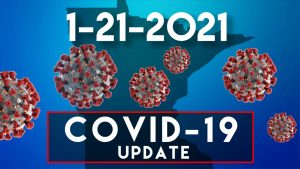1-21 COVID-19 Update: As Students Return to Classrooms, Minnesota Implores More Testing
1-21 COVID-19 Update from Minnesota Department of Health

The Minnesota Department of Health will hold a conference call at 2 p.m. Thursday to brief members of the media on the latest public health information regarding COVID-19.
To watch the full briefing, click here.
MDH Commissioner Jan Malcolm:
- Globally, 96.2 million cases since start of pandemic; 2.06 million deaths
- In U.S, 24.5 million cases since pandemic began (up 184,000); 406,000 deaths (up 4,400)
- In Minnesota, 450,762 total positive cases (up 1,292)
- Of the 450,762 cases, 433,722 (96%) no longer need isolation
- In Minnesota, 6,011 total deaths (up 32)
- Today’s newly reported deaths in Minnesota surpass 6,000 threshold
- Of 32 newly reported deaths, 15 were residents of long-term care/assisted living
- 4 weeks since Christmas, Malcolm said there was only a modest spike from the holiday
- Malcolm mentioned she would to see testing increase in Minnesota, which has ample capacity
- 7-day average case positivity rate dropped to 5.1% as of Jan 12
- Case positivity rate has one-week lag period.
Update on Vaccinations:
- 246,364 doses administered (as of Monday)
- 41,984 people have completed their vaccinations in Minnesota
- Pfizer and Moderna vaccines require two doses separated by about 3-4 weeks
- Vaccinations set aside this week for school districts in CCX News viewing area:
- Wayzata: 27 doses
- Osseo: 47 doses
- Robbinsdale: 30 doses (unconfirmed)
- Hopkins: 20 doses (unconfirmed)
MDH Director of Infectious Disease Kris Ehresmann:
- The Minnesota Department of Health launched new online survey for COVID-19 case investigation today as part of an effort to make this public health strategy faster and easier for Minnesotans contacted about COVID-19 cases.
- When someone tests positive for COVID-19, MDH will send them a text message inviting them to participate in a survey.
- Typical case investigation process involves public health workers calling someone who has tested positive for COVID-19, but contacting people by phone isn’t always the quickest or easiest method.
- Contact tracing can’t happen until a case investigation is complete.
- “This survey means people who have tested positive don’t have to wait for a call,” said Ehresmann.
Testing Recommendations Updated for Students, Especially Ages 12-25
The Minnesota Department of Health updated its COVID-19 testing recommendations, focused primarily on students, ages 12-25, returning to schools, youth sports and extracurricular activities
Students who should get tested include:
- Students returning to school, youth sports or extracurricular activities who are ages 12 to 25 years old
- College and trade school students returning to campus or classes
- Anyone who regularly interacts with people outside of their family unit or household.
- This is in addition to anyone with symptoms, anyone who was exposed to someone who tested positive, or anyone who is working at places that remain open during the pandemic, such as critical infrastructure, first responders, health care, retail, schools and child care.
“Testing remains one of the most powerful tools we have to stop the spread of COVID-19,” said MDH Assistant Commissioner Dan Huff in a statement to CCX News. “We’ve worked tremendously hard and Minnesotans have made a lot of sacrifices to get students back to their classrooms, sports, and extracurricular activities. Active testing by children, college and trade school students, and those who regularly engage with folks outside of their household—like our teachers—will protect our progress and mitigate the spread of the virus.”
The expanded recommendations complement the increase in testing focused on educators and staff. Earlier this month, Governor Walz announced that the state would provide training and saliva test kits so that all schools providing in-person or hybrid learning can offer on-site testing to all staff who interact with students.
While testing is not required for K-12 teachers or staff, it is required for schools to offer the testing every other week. Since the testing program began, more than 17,000 staff have been tested, with a 0.36% positivity.
Residents have several ways in which they can access no-barrier testing, including more than 20 community testing sites, a mail-order at-home test program, and clinics and hospitals across the state. Tests remain no-cost, but each person getting tested is asked to provide insurance information so the state can seek reimbursement from insurance companies.
To learn more: Who should get tested?
Q&A Session and Notes:
- Most people will eventually be getting their shots from their health care provider or local pharmacy, said Malcolm.
- “There is much, much still in flux,” said Malcolm about the vaccination delivery system. All options on table, including possible large-scale vaccinations at stadiums.
- What about the younger students who have already returned to school and getting tested? “We encourage everyone that’s returning back to school, whether you be a 6-year-old, or a 12-year-old or a 22-year-old to go get tested,” said Huff. Says ages 12-25 more likely to move outside family “pod.”
- Still working to vaccinate all frontline workers and nursing home residents in Phase 1a.
- Minnesota expects to receive about 60,000 doses of vaccine again next week.
Brooklyn Center | Brooklyn Park | Champlin | Crystal | Golden Valley | Maple Grove | New Hope | Osseo | Plymouth | Robbinsdale | Rogers | Twin Cities | Wayzata



